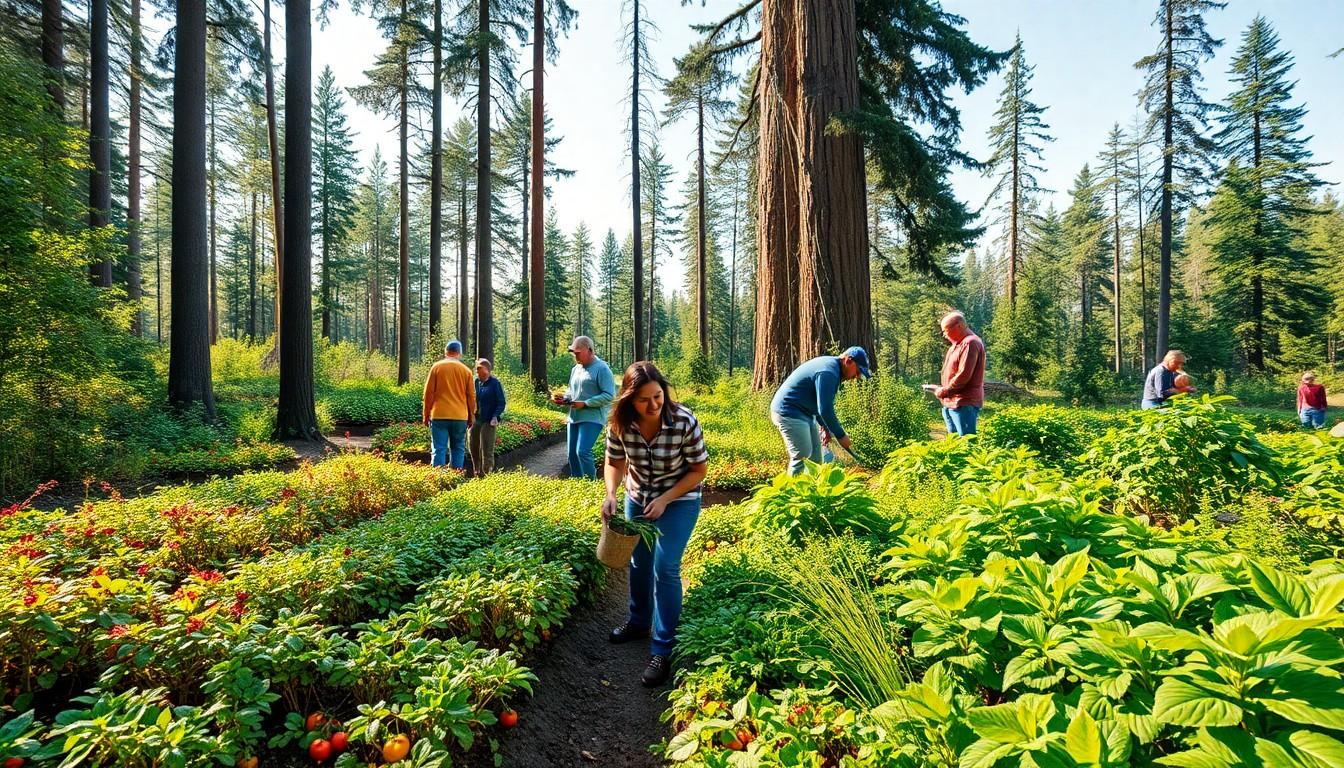Phone:
(701)814-6992
Physical address:
6296 Donnelly Plaza
Ratkeville, Bahamas.

Imagine stepping into a lush, green paradise where fruit trees mingle with vibrant flowers and vegetables peek out from beneath a canopy of leaves. Welcome to forest gardening, the ultimate eco-friendly way to grow your own food while channeling your inner woodland elf. This sustainable practice not only boosts biodiversity but also creates a self-sustaining ecosystem that practically runs itself—talk about a low-maintenance garden!
Forest gardening serves as a sustainable approach to food production that mimics natural ecosystems. This practice incorporates layered planting, combining trees, shrubs, perennials, and annuals to maximize space and resources. Biodiversity thrives in these environments, fostering a balance that supports various species, from pollinators to beneficial insects.
Root systems in forest gardens enhance soil health, improving water retention and nutrient cycling. Organic matter builds through fallen leaves and decomposing plants, enriching the ground without synthetic fertilizers. Crops receive sustenance from this nutrient-rich soil, growing stronger and healthier.
The diversity of plants grown in forest gardens includes fruit trees, nuts, berries, vegetables, and herbs. These selections yield food year-round, providing both variety and nutrition. This practice encourages foraging, creating opportunities to harvest fresh produce directly from the garden.
Maintenance of forest gardens requires less effort than traditional farming methods. Minimal tilling, weeding, and pest control enhance the ecosystem’s stability. Pests find natural predators within the garden, reducing the need for chemical interventions.
People engage in forest gardening not only for food but also for community building. Educational programs often arise from these gardens, teaching sustainable practices and environmental stewardship. With the growing interest in health-conscious lifestyles, forest gardening appeals to those seeking fresh produce and a connection to nature.
Forest gardens thrive in urban and rural settings, complementing landscapes while providing ecological benefits. Enhanced local biodiversity reflects positively on the environment, making forest gardening an impactful choice for sustainable food systems.

Forest gardening offers multiple benefits that contribute to sustainability and well-being. These advantages span environmental, health, and community aspects.
Biodiversity thrives in forest gardens, providing habitats for numerous species. Carbon sequestration occurs naturally as trees absorb CO2, mitigating climate change impacts. Soil quality improves significantly through organic matter, leading to healthier ecosystems. Efficient water management results from diverse root systems, enhancing retention and reducing runoff. Pesticide use diminishes due to natural pest control methods, promoting ecological balance. Energy consumption decreases as forest gardening minimizes the need for machinery, creating an environment that supports life.
Nutrition improves via access to diverse fruits, vegetables, and herbs throughout the year. Fresh produce harvested from forest gardens contributes to a healthier diet, enriched with vitamins and minerals. Physical activity increases as individuals engage with gardening tasks, promoting better fitness levels. Mental well-being benefits from spending time in green spaces, which has been shown to reduce stress and anxiety. Community bonds strengthen when individuals collaborate in gardening efforts, fostering a sense of belonging. Thus, forest gardening addresses both physical and emotional health needs effectively.
Forest gardening relies on key design principles that foster a sustainable ecosystem. These principles maximize productivity while enhancing biodiversity.
Layering strategies create a diverse vertical environment. The practice involves planting different species at various heights, including canopy trees, understory trees, shrubs, herbaceous plants, and ground cover. Canopy trees provide shade and habitat, while understory trees benefit from this shielding. Shrubs add another layer of food sources, supporting wildlife and human foraging. Ground covers help retain moisture and suppress weeds, promoting healthy plant growth. Adopting these strategies optimizes space and resources in forest gardens.
Companion planting works to enhance plant relationships. Certain plants benefit from being grown together, such as nitrogen-fixing legumes paired with leafy greens. This arrangement improves soil fertility and minimizes pest issues. Additionally, flowers attract pollinators that support crop yields. Mix berries with herbs like basil for flavors that complement each other, improving nutrition and flavor. Utilizing companion planting encourages a thriving garden ecosystem while maximizing available space and resources.
Forest gardening employs a diverse array of trees and plants, each selected for their unique contributions to the ecosystem.
Diverse nutrient-rich varieties thrive in forest gardens. Fruit trees like apple, pear, and cherry provide essential vitamins and minerals. Nut trees such as walnut and hazelnut contribute healthy fats and protein. Berries like blueberries, strawberries, and blackberries offer antioxidants and flavor. Leafy greens, including kale, chard, and spinach, deliver vital nutrients and can be grown alongside other perennials. Incorporating herbs like basil, thyme, and mint enhances culinary possibilities while attracting beneficial insects. The combination of these nutrient-dense plants supports a balanced and healthful diet throughout the year.
Utilizing native species strengthens forest gardens’ resilience. They adapt well to local climates and require less water. Trees such as oak, maple, and black cherry foster biodiversity by providing habitats for various wildlife. Native shrubs like elderberry and serviceberry yield edible fruit while supporting pollinators. Ground covers such as creeping thyme and wild strawberry prevent soil erosion and promote soil health. By including native plants, gardens achieve greater ecological balance and stability. This approach promotes increased interactions among local flora and fauna, enriching the overall biodiversity within the garden.
Forest gardening faces several challenges that can impact its overall success and sustainability.
Pest management presents significant challenges in forest gardening. Various plants attract pests that can damage the ecosystem. Utilizing companion planting techniques can effectively deter harmful insects while promoting beneficial ones. Manual removal and monitoring routines help maintain pest populations at manageable levels. Organic treatments, such as neem oil and insecticidal soap, provide additional support in managing pest issues without harming the environment. Understanding the specific pest dynamics within the garden environment also aids in creating effective prevention and control strategies.
Climate considerations play a crucial role in the viability of forest gardening. Local climate influences plant selection, growth rates, and seasonal productivity. Certain plants thrive in specific temperature ranges and rainfall levels, making adaptability essential for success. Soil quality and weather patterns impact moisture retention and nutrient cycling, influencing overall garden health. Observing microclimates within the garden helps optimize plant placement and resource allocation. Adjusting management practices to account for changing climate conditions ensures long-term sustainability and resilience.
Forest gardening stands as a transformative approach to sustainable food production. By integrating diverse plant species and mimicking natural ecosystems, it not only yields nutritious food but also fosters a thriving habitat for wildlife. This method reduces the need for chemical inputs and labor-intensive maintenance while enhancing soil health and water retention.
Engaging with forest gardening cultivates community connections and promotes environmental stewardship. As more individuals and communities adopt this practice, they contribute to a greener planet and healthier lifestyles. Embracing forest gardening is a step toward a sustainable future, where food security and biodiversity go hand in hand.